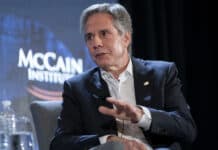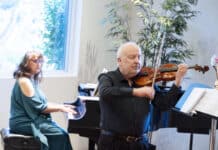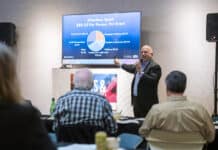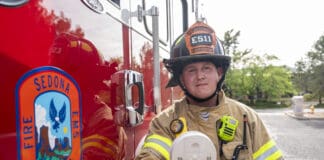According to the artists participating, the Sedona Summer Arts Colony is building a community.
A mixed batch of artists from many media has come to Verde Valley School for the three-week program, now in its second year.
Three dorms are being used at the boarding school and various studios are filled with the sounds of drums, murals on butcher paper and red rockinspired ceramics. Meals and outings are provided, and new to this year, the local public can join in through day residency programs.
After speaking with many of the colonists, the program has reached out to so many corners of the country by word of mouth. People came from Key West, Fla., Baton Rouge, La., and New Jersey to attend.
The feeling of community was apparent right at breakfast. Unlike a school, or as many people described other residency programs, people had not broken down in to specific cliques. Tables were crowded around by as many people as could fill them, and composers spoke with painters without missing a beat.
Tom Elden Anderson said that the colony broke down the different lexicons that artists use to talk about their specific medium.
Anderson hails from Louisiana, where years earlier he had met the colony’s organizer, the Sedona Arts Center’s Executive Director Eric Holowacz. Anderson had just finished up a podcast, and had a slew of Science magazine clips spread out to make a collage afterward.
Anderson said he hoped to expand on the idea of “crisis of imagination.”
Anderson described this crisis as one of failed communication. He lamented the separation of business and hard sciences from the arts, noting that in his experience, even the highest-level businessman has a level of creativity. But without recognizing that creativity and its inherent advocacy, arts programs lose funding and innovation suffers.
Anderson has a background in theater and crisis management, and has worked both sides of the ideological field as a result. He has been on disaster sites of national scope, including 9/11, hurricane Katrina and the BP oil spill in the Gulf of Mexico.
He said he liked the time the colony provided for focus and being able to expand his ideas through critiques and discussion. At another building, four women were talking over knitting, led by Lisa Barnes, who teaches classes in various techniques back home. They described the studio as the nexus of the colony, both as a meeting place and an area to develop ideas.
The other artists — all there for other reasons — said they had come to appreciate the meditative quality of the needle arts. Before a nosey reporter entered the room, the conversation had spanned the world of art, politics and beyond.
Barnes said she hopes to create six new techniques during her residency, and hopes to teach them throughout the following year. She has started to teach online as well, and liked the connectivity of new technology but appreciated the down-to-earth nature of the colony.
Earlier in the program, Holowacz emphasized this point by bringing many of them to Bell Rock to be able to touch the rocks and more literally connect with their surroundings.
Technology and its influence was the subject of one needle student’s project. Kim Romano is a filmmaker working on a piece that will explore the relationship between psychotherapy and artificial intelligence. During the colony, she said much of her time was dedicated to research and preparing, not having a camera or crew there. Romano wants to look at facial recognition software and how it might help analyze people’s feelings.
She plans to explore the validity of these claims and how therapists might adopt these technologies. Beyond that, she wanted to look at the Internet of Things and how data generated from smart devices in the home could affect how people see one another and whether emotions and possibly trauma would be more visible as a result.
She also questioned how it could affect the blind’s ability to interact with the world via informative software that could clue in facial expressions and body language without touch.
Around the corner was Dora Hernandez. She had a more deadline-driven focus than some others, having a show in December at the Xico Latino and Native American Arts Organization in Phoenix.
Her ceramics projects have taken on a large scope, she said, and will be working with SAC ceramics instructor Dennis Ott in Uptown since the kilns at Verde Valley School are not big enough to fire her work.
Her spiraling, twisting patterns took their cue from the rock formations, even though as a Phoenician, she had come up here without the expectation of being inspired by the area. She said the nicest thing about the colony was the people, both their open minds and the drive that everyone had shown.
Another who had her own Sedona experience was Judy Grossman. Over breakfast, she showed a series of pictures taken at a vortex which had one remarkable feature: A shaft of light that bent nearly like a rainbow down to the ground, taken from only 20 or so feet away. What was more, the image stayed even as she moved around the area, eliminating the possibility of a lens flare.
She said she didn’t come to the colony with any specific plan, and thought she would be one of the only people to do so. She expected many colonists to bring their ongoing projects but was surprised to see that wasn’t the case.
As a professional sign designer who also does art on a commission basis, she enjoyed being able to “shed the skin of everyone else’s requests” and find what she wanted. She said that her best pieces had been more spontaneous so far, making her question some of the values of planning.
Having her art appreciated by her peers was another large benefit of the colony for her. Coming from California, bordering Yosemite National Park, she said it isn’t always as meaningful when someone in passing says he or she likes work without understanding everything that went into it.
Learning about the mindset of other artists has been great, too, she said.
Throughout the camp, Holowacz’s impact was obvious. The participants of his brainchild all knew him as he toured around, and he was invested in everyone’s progress.
It was not the productive grind of an assembly line, but art was being created along with a new addition to the arts scene that the red rocks have become known for.
Whether artists chose to come for a day, a week or the full three weeks, all were looking forward to the colony returning next year.





















